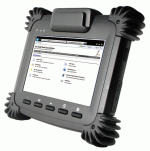Published on the 28/05/2012 | Written by iStart

And a six-step reality check you should complete before being seduced by shiny enterprise app extensions and sexy gadgets…
Mobile phones have become such a part of our daily lives that we all expect mobile computing to seamlessly flow into our business lives as well and become an integral part of how we work. With a smartphone in our pocket and access to thousands of apps, we have become the mobile generation − performing a wide range of information intensive activities on mobile phones wherever we are − viewing latest rugby scores of our favourite team, conducting banking transactions, searching for a local restaurant or sending messages to our Facebook friends. This connectedness and rich capability has meant business leaders are able to easily see how mobility could deliver significant benefit to their workforces. Workers being always on, always connected and informed means they can be performing critical roles without having to be in the office. Almost 60 per cent of senior corporate executives expect mobile technology to provide the biggest boost to their businesses over the next five years according to Oxford Economics in their recent Digital Megatrends 2015 report. This is in contrast to the 35 per cent expecting gains from business intelligence and cloud computing, and about 30 per cent for social media. The attraction is strong for executives wanting to access the benefits of mobility for their teams, but industry experts are also cautioning against leaping into extending business applications onto mobile devices. But firstly, what has bought about the strong interest in mobility? Andrew Fox, head of mobile solutions, SAP ANZ provides some insight: 1. Powerful devices: A few years ago, mobile phones were bulky and not powerful, and networks were cripplingly slow. The current generation of smartphones is equipped with dual-core processors, fast memory and storage, and sharp displays. Another difference is bandwidth. In 2001, mobile phones puttered along at 14.4 kilobits per second. Now, 3G, 4G and Wi-Fi enabled mobile devices allow users to download lots of data and graphics at very fast speeds. Gartner says by the end of 2016, 1.2 billion people will carry powerful smartphone handsets and tablets, such as Apple’s iPad and devices based on Google’s Android mobile operating system. A large installed base of these devices has accelerated the focus on mobile computing. 2. Availability of pre-integrated apps: Many vendors of enterprise systems are pre-packaging mobile apps, downloadable from iTunes and other market places, to enable their customer’s mobile workforce to quickly make decisions no matter where they are. These apps allow them to: a. View upcoming tasks and scheduled activities, so employees can always be on top of their game b. Get alerts on specific events such as deviations from approved discounts, prices, credit limits, or targeted gross profits c. View and complete approval requests or ask for additional information or provide comments to requesters in the approval and rejection process d. Access real-time operational reports to have up to date information at their fingertips
“…This has led to a race to push out applications as a competitive tool to improve relationships and Gartner Inc e. Access and manage customer and partner information, including contact details, historical activities, and past orders f. Monitor inventory levels, and access detailed information about products, including purchasing and sales prices, available quantity, manufacturer, shipping type, product specifications etc. 3. Basis of competitive advantage: Using mobile technology during customer interactions allows organisations to become more responsive to their customers (a great competitive advantage over other companies), and it enables them to appear rich in resources (a huge coup in perception management for mid-sized companies). They can also get access to the latest operational scorecards to know where they are (by the minute) in terms of meeting their metrics. With ERP and BI vendors offering pre-built mobile apps at no additional cost, even small organisations can afford to mobile-enable their workforce. Gartner in a 2011 strategic technologies outlook stated that, ‘The quality of the experience of applications on these devices, which can apply location, motion and other context in their behaviour, is leading customers to interact with companies preferentially through mobile devices. This has led to a race to push out applications as a competitive tool to improve relationships and gain advantage over competitors whose interfaces are purely browser-based.’ 4. Shift to cloud computing: Organisations are accessing business applications and business intelligence software using the SaaS (Software as a Service) model. In addition, increasing amounts of company data resides in the cloud. Most of these SaaS applications have web services APIs and most of the data on the cloud is consumed using web services. Unlike traditional systems, SaaS applications and cloud-based data can be easily accessed using web services by mobile platforms. 5. Executive interest: The iPad was one of the most popular Christmas gifts last year – many senior executives got an iPad for Christmas and asked their IT departments to help them access their corporate systems using their new toy – whether for reading their email, checking the status of their customer’s order, approving a purchase requisition for their department, or reviewing a product plan. As a result of the success of the iPad with executives, interest in mobile computing has received attention at the highest levels. “These factors suggest mobile computing in business is not only here to stay, it will become the very fabric of how we will work,” says Fox. “Organisations that do not deploy mobile apps from their enterprise vendors (or build their own apps on top of their applications and data) will be at a disadvantage.
“These factors suggest mobile computing in business is not only here to stay, it will become the very fabric of how we will work.”
Andrew Fox, head of mobile solutions – SAP ANZ “But don’ t forget the reality check,” cautions Stuart Dickinson, chief executive, Oxygen Business Solutions. “One of the best things about working in the information technology industry is….yes, the technology,” says Dickinson, “but when it comes to mobility it is important to consider the business case before being seduced by the devices.” “I speak with the nagging sense of personal guilt which comes from being an IT professional who has succumbed to non-rational buying decisions – leading to simultaneous ownership of both a Blackberry and an iPhone, and a laptop bag which just got a little bit heavier with the addition of an iPad.” “I am not alone. Mobility is the buzz word of the day. The proliferation of appealing mobile devices, faster broadband, and cloud-based applications, all conspire to add appeal and glamour to the ability to use technology anytime, anywhere, free of the physical constraints of conventional networks.” Industry forecasts add fuel to the fire. Last year Cisco announced – with understandable enthusiasm – that global mobile data traffic will grow annually at 131 per cent (CAGR) through to 2013 (and likely beyond). Gartner’s most recent forecast on global IT spending saw a reduction in year-on-year growth across the entire industry from 5.3 per cent to just 3.9 per cent. At the same time, Gartner is forecasting 9.1 per cent growth in hardware fuelled by growing demand for mobile devices and PC upgrades linked to Windows 7. Dickinson continues “Everyone wants to be mobile and many of us have been guilty of buying the latest mobile gadget without really thinking through just what the business benefits will be. “This is harmless enough on a personal level, but buying decisions at an organisation level must be underpinned by a hard-nosed understanding of the business benefits and a solid business case. “The mobile device should come last in the decision sequence – post the establishment of the use case for the role and the actual applications to be mobilised – and NOT first as is often the case. Deploying the right device to meet the use and business case requirements will often make or break the actual business case,” he says.
“Deploying the right device to meet the use and business case requirements will often make or break the actual business case.”
Stuart Dickinson, chief executive, Oxygen Business Solutions Dickinson advises that use cases, by role, need to be defined prior to embarking on deployment of enterprise mobile applications, and any analysis shows that not every role has the same requirements for mobile application access. Oxygen has developed a six step plan to ensure that the horse is placed firmly in front of the cart when it comes to advising on and managing the implementation of organisation-wide mobility solutions; 1. Understand the business requirements and the context of those requirements – go out on the road with the end users to understand and sanity check perceived requirements against real requirements. 2. Identify the application which most closely fits the business requirement. 3. Resolve the deployment, security and architecture issues. 4. Match the business requirement to the role and then establish what type of device meets the requirements. 5. Start with a small pilot to assess effectiveness and measure productivity or improvement results. 6. Finally – plan and manage large scale deployment based on a business case understanding of the costs relative to benefits. The reality is that mobile deployments need to be highly structured and carefully managed. As with all technology deployments the business requirements have to be paramount and the cost/benefit of mobile deployments need to be fully understood up front. Mobility has strong business advantages but it also has the potential to pose serious risks if security and architecture issues are not identified and managed to a robust standard. The bottom line is that mobility decisions have to be made without any emotional attachment to cool devices. Follow good process. A reality ‘check’ after the fact will likely be one you won’t want to cash. Oxygen Business Solutions is a SAP Gold partner. … gain advantage over competitors whose interfaces are purely browser-based. “
gain advantage over competitors whose interfaces are purely browser-based. “



































